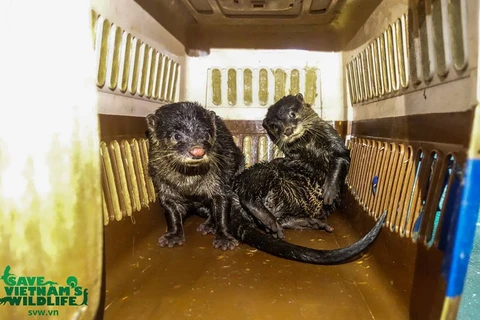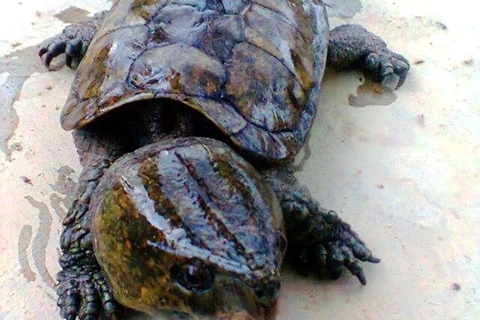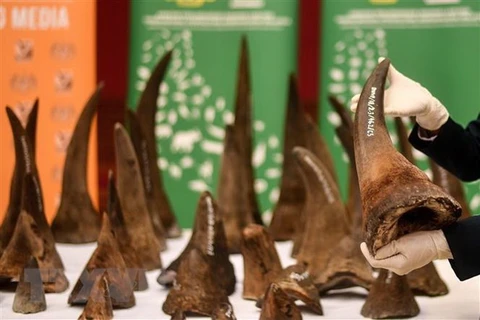 The elusive Annamite striped rabbit (Nesolagus timminsi) in a photo snapped by a camera trap in the wild. (Photo courtesy WWF)
The elusive Annamite striped rabbit (Nesolagus timminsi) in a photo snapped by a camera trap in the wild. (Photo courtesy WWF)
Thua Thien-Hue (VNS/VNA) - A new study has provided the first detailed information about the Annamite striped rabbit (Nesolagus timminsi) – a little-known lagomorph not discovered until 1995.
The study was carried out by the Leibniz Institute for Zoo and Wildlife Research (Leibniz-IZW) in collaboration with WWF-Vietnam, WWF-Laos and the Central Institute for Natural Resources and Environmental Sciences (CRES) of the Vietnam National University.
WWF-Vietnam said the study was published in the international journal Oryx.
Researchers used camera trapping to study the Annamite striped rabbit in five areas of Vietnam and Laos. Camera traps placed across the landscape showed that although the rabbit was found in all the areas, the species was not common in any of them, and in one protected area it appeared to be approaching local extinction.
These results show that intensive poaching in Vietnam and Laos, accomplished by setting wire snares, has clearly impacted striped rabbit populations. However, the fact the species still exists in the region that has experienced such intensive snaring provides hope that, with effective anti-poaching efforts, these populations could recover.
According to WWF-Vietnam, the Annamite mountains of Vietnam and Laos harbour exceptional species richness and endemism, but their wildlife is under threat from widespread and intensive poaching.
“It is exciting to provide the first insight into such an elusive species,” says Andrew Tilker, a PhD student at Leibniz-IZW and an Associate Conservation Scientist at Global Wildlife Conservation.
“Of course, this information is interesting from a scientific perspective, but more importantly it can help inform evidence-driven conservation initiatives,” he said. “Our results provide exact locations for targeted snare removal efforts. We also establish the first conservation baseline for the species, which can be used to monitor population trends.”
Dr. Ben Rawson, WWF-Vietnam’s Conservation and Programme Development Director, hopes intensive efforts to halt snaring will result in rebounds in rabbit populations.
“With continued snare removal efforts in the Saola Nature Reserves led by WWF and our local partners, we are confident that this remarkable species can thrive,” Rawson said.
One of the most significant findings of this study is that the Annamite striped rabbits live in an unprotected forest area in Laos, near a remote village called Ban Palé. The presence of this kind of rabbit in the Palé area – along with other rare and threatened species – further supports ongoing initiatives to grant this area officially protected status. The Palé area is under imminent threat from illegal hunting, logging and gold-mining operations.
Francois Guegan, Conservation Director for WWF-Laos, said: “We must act now to stop these threats and to provide effective protection to Palé. We have to work together, and we have to act fast. Otherwise we will lose the Annamite striped rabbit and other conservation-priority species from this site.”
“The Annamite striped rabbit is part of what makes the Annamites unique,” says co-author of the study Associate Professor Minh Le from the Vietnam National University. “This study shows how fragile the species’ survival is, even in protected areas.”
An Nguyen, Field Coordinator for the Leibniz-IZW project, agrees.
“The species is hanging on – but for how much longer? We need to improve law enforcement, stop snaring and reduce demand for bush meat. One organisation alone cannot do this. We need to work together if the Annamite striped rabbit is to survive.”-VNS/VNA























